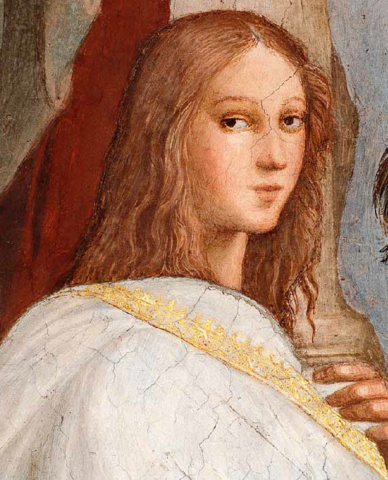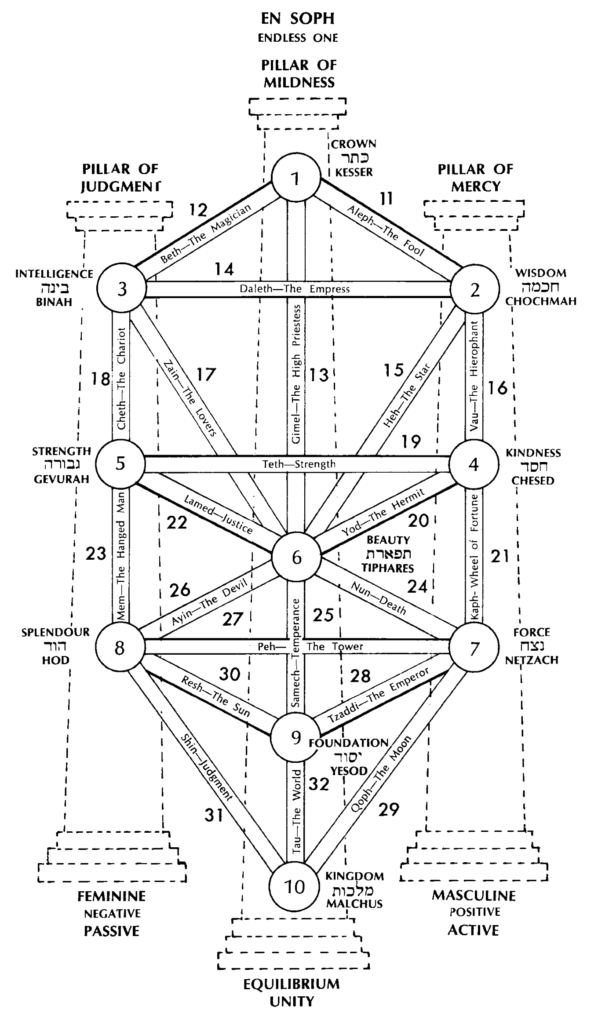
This is Part II of The Kabbalah and the Occult Tarot, which covers how Kabbalistic commentary joined esoteric interpretations of the tarot.
Part I: Roots and Seeds of the Kabbalah introduces the history and some basic concepts of the Kabbalah.
– If you’re unfamiliar with the tarot, here’s a quick intro.
Although many occultists consider it no coincidence that the Hebrew word Torah and the word tarot are similar, the Kabbalah texts handed down by the Jewish masters do not mention the tarot in any way, shape, or form.
Evidence indicates that the earliest extant decks were created in late Medieval Italy as a game, not as esoteric or occult devices, centuries after the earliest known Kabbalah texts.
That said, the historical parallels between the introduction of the Kabbalah outside the Jewish community in Europe and the spread of tarot cards are simply too interesting to be ignored, even if they don’t mean, or even imply, that the tarot was created by Jewish mystics, or that the creators of the tarot had the Kabbalah in mind.
Renaissance and the Kabbalah
The distribution of ancient Greek and Roman art and literary works gets credit for sparking the Renaissance of Italy, but Christian intellectuals in sixteenth century Italy also expressed a keen interest in esoteric Judaism.
That interest gave rise to what Dr. Scholem calls the Christian or christological Kabbalah. Pico della Mirandola (1463–1494) enjoyed philosophical friendships with Italian Jewish intellectuals and commissioned translations of Kabbalistic texts, on which he expounded in several of his works. Scholem calls della Mirandola “the founder of this Christian school of Kabbalah.” Other Christian Kabbalists include Cornelius Agrippa of Germany (1486–1535), the German theosophist Jacob Boehme (1575–1624), and Robert Fludd of England (1574–1637).
As Kabbalistic commentary spread, each part of the Tree of Life gained new members in its entourage, so to speak, of angels and demons, celestial bodies, letters and words, numbers, elements, colors, astrological signs, key meanings, and so on. Alchemical symbolism, for example, gave the Christian Kabbalah, as Dr. Scholem says, “an oddly original character in its final stages of development in the 17th and 18th centuries.” (p. 200)

A near endless catalogue of symbols drawn from alchemy and other arts came to animate Kabbalistic commentary: kings and queens; celestial vehicles and chemical dishes; gold, silver, copper, and lead; the zodiac; various animals like snakes, lions, and dogs; pagan deities; drugs and plants; virtues and vices; and, of course, tarot cards. The influx of magical and occult practice in turn gave rise to what is often called the Hermetic Kabbalah.
These shared symbols can be considered a bridge between Kabbalah and the occult tarot, but in order to describe the Kabbalah as it relates to tarot, it’s best to depart respectfully not only from the illustrious work of traditional Kabbalists and later Christian commentators, but from the earliest extant tarot decks and writings on tarot, for none of these draws a documented connection between the tarot and the Kabbalah.
The Kabbalah and the Occult Tarot
Eliphas Levi’s 1854 Dogme et Rituel de la Haute Magie (Transcendental Magic, its Doctrine and Ritual, trans. AE Waite) drew from earlier European works on the Kabbalah, but Levi’s is the first (known) text to associate tarot with the Kabbalah.
With more or less erudition, others who followed him — Papus, Oswald Wirth, Arthur Edward Waite, and Gareth Knight, for example — demonstrated that the Kabbalah can be adapted as an intriguing framework for interpretation of the tarot deck. The Kabbalah’s accretion of symbolism facilitates its elements taking root in the tarot.
Kabbalistic Correspondences to Tarot
The Tetragrammaton or Hebrew name of God comprises the four Hebrew letters yod-heh-vau-heh and is frequently transliterated as YHWH, JHVH, or IHVH and pronounced Yahweh or Jehovah. It has been associated with the parts of the tarot deck: yod for the four suits; heh for the court cards; vau for the pip cards; and final heh for the Major Arcana.

The following correspondences are drawn from those made by members of the Hermetic Order of the Golden Dawn, a fraternity centered on magic and the occult, mostly active at the turn of the 20th century. Other tarotists have put forth other systems of correspondences, but since the Golden Dawn’s system is most influential and enduring, it is presented here.
The Major Arcana and the Paths between Sephiroth
Occultists have placed the Major Arcana cards on the paths of the Tree of Life. They have also matched a Hebrew letter with each Major Arcana card, usually in sequence down the Tree, as shown in the diagram, with 0 The Fool and I The Magician at the top, proceeding downward to 21 The World.
The Numbered Cards (Pips) of the Minor Arcana and the Sephiroth
The numbered cards of the tarot Minor Arcana have been paired with the Sephiroth, as well as elements (aces) and key words or phrases.
1 Kether: The Crown: Ace of Wands: Roots of the Powers of Fire | Ace of Cups: Root of the Powers fo Water | Ace of Swords: Root of the Powers of Air | Ace of Pentacles: Root of the Powers of Earth
2 Chokmah: Wisdom: Two of Wants: Dominion | Two of Cups: Love | Two of Swords: Peace restored | Two of Pentacles: Harmonious change.
3 Binah: Understanding: Three of Wands: Established Strength | Three of Cups: Abundance | Three of Swords: Sorrow | Three of Pentacles: Material works
4 Chesed: Mercy or Love: Four of Wands: Perfected work. | Four of Cups: Pleasure | Four of Swords: Rest from strife | Four of Pentacles: Earthly power
5 Geburah: Strength or Severity: Five of Wands: Strife | Five of Cups: Loss in pleasure | Five of Swords: Defeat | Five of Pentacles: Earthly trouble
6 Tiphareth: Beauty or Mildness: Six of Wands: Victory | Six of Cups: Joy | Six of Swords: Earned success | Six of Pentacles: Material success
7 Netzach: Victory or Firmness: Seven of Wands: Valour | Seven of Cups: Illusory success | Seven of Swords: Unstable effort | Seven of Pentacles: Success unfulfilled
8 Hod: Glory or Splendor: Eight of Wands: Swiftness | Eight of Cups: Abandoned success | Eight of Swords: Shortened Force | Eight of Pentacles: Prudence
9 Yesod: Foundation or Basis: Nine of Wands: Great Strength | Nine of Cups: Material happiness | Nine of Swords: Despair and cruelty | Nine of Pentacles: Material gain
10 Malkuth: Kingdom: Ten of Wands: Oppression | Ten of Cups: Perfected Success | Ten of Swords: Ruin | Ten of Pentacles: Wealth
The Minor Arcana Suits and the Four Kabbalistic Worlds
The Sephiroth, as stated before, act in four worlds, four modes of being, which move from ineffable to material, or as MacGregor Mathers described the four worlds put it, “in a descending scale of brightness.” Occultist Gareth Knight said, “The four worlds indicate the manner in which spiritual force manifests itself and comes down into form in the physical world.”
World | Description of World | Hebrew letter | Tarot suit | Court Cards Element
- Atziluth | Archetypal | yod | Wands | Kings | Fire
- Briah | Creation / heh | Cups | Queens | Water
- Yetzirah | Formation | vau | Swords | Knights | Air
- Assiah | Action | heh (final) | Pentacles | Pages | Earth
Studying the Kabbalah, Studying the Tarot
Again, these only sample the associations made between aspects of the Kabbalah and the cards of the tarot starting in the nineteenth century CE.
As a system to memorize the meanings of the cards, the diagram of the Tree with tarot overlay can be useful. Conversely, the tarot can be used as a visual and organizational aid to study the Kabbalah.
RENAISSANCE ITALY: GLORY, BEAUTY, GREED, WAR.
A POWERFUL HOLY WOMAN. THE INQUISITION….
A novel based on the true story of the Popess card of the tarot.
BUY: Signed by author, free shipping in US
BUY: bookshop.org | Amazon US | Amazon CA | B&N | indiebound
“Enchanting & richly historical, heart-wrenching & intoxicating.” —Stuart R. Kaplan, author Pamela Colman Smith.
“A storytelling treasure. The sights, smells, feel of Renaissance Italy seep from every pore of the story.” —Ron Andre, A Matter of Fancy
SOURCES
Fortune, Dion. The Mystical Qabalah. 1935; reprint, York Beach, ME: Weiser Books, 2000
Kaplan, Stuart R. The Encyclopedia of Tarot, vols. I and III. New York: U.S. Games Systems.
Knight, Gareth. A Practical Guide to Qabalistic Symbolism. York Beach, ME: Weiser Books, 2002.
Mathers, McGregor. The Kaballah Unveiled. 1887, reprint 2020
Scholem, Gershom. Kabbalah. New York: Dorset Press, 1974. 495 pp. cloth.
A few interesting, unexpected contemporary takes on the Kabbalah…
Correspondences of the Kabbalah, the Tree of Life, and the Coen brothers film The Big Lebowski, illustrated, here
Kabbalah and alchemy, drawn in mind-boggling intricacy, by David Chaim Smith
BRIEF INTRODUCTION TO TAROT
Tarot cards were originally used for gaming but their use for divination and occult and spiritual studies is more well known today. Many variations of tarot decks have been issued. Traditionally, the deck has two main parts. The trumps, or Major Arcana, comprise 22 cards, numbered 0 through 21, with symbolic or allegorical illustrations on their faces. The suit cards, or Minor Arcana, comprise four suits of fourteen cards each: swords, batons / wands, cups, and coins / pentacles. Each suit comprises ten numbered cards (pips) and four court cards: king, queen, knight, and page. back to top
